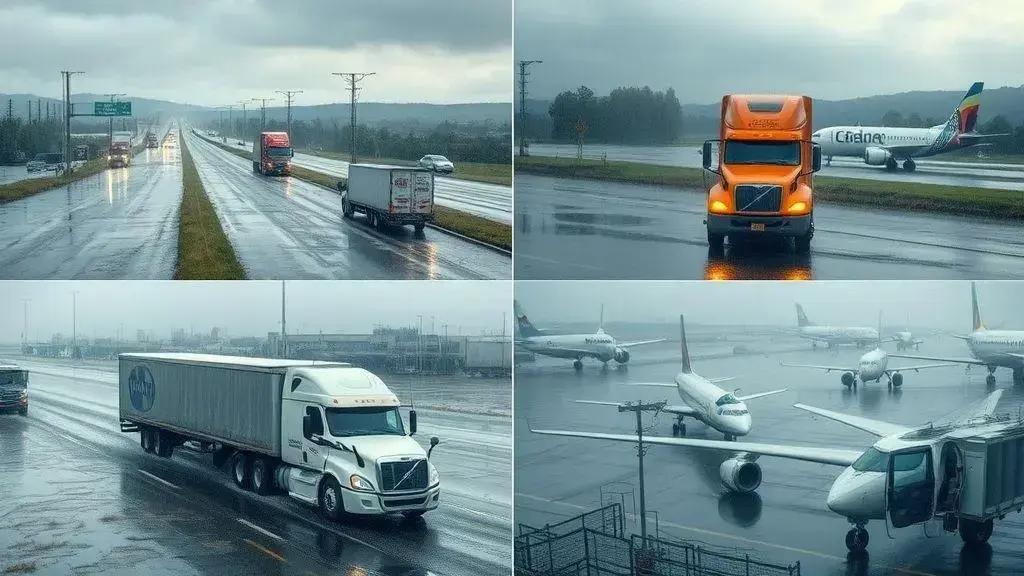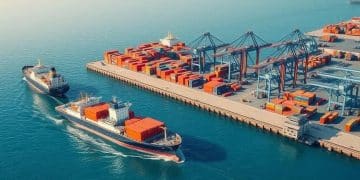Extreme weather event disruptions rise increasingly in 2025

Extreme weather event disruptions are rising, impacting transportation, logistics, and economies, highlighting the need for effective community preparedness strategies to reduce damage and enhance resilience.
Extreme weather event disruptions rise significantly in 2025, affecting daily life and business operations. Have you considered how these changes might impact you or your community?
Overview of extreme weather events
Extreme weather events are becoming more common, and their impact is significant. Understanding these events is crucial for all of us.
Extreme weather can be defined as unusual weather patterns that are significantly different from the average conditions in a given area. These can include floods, hurricanes, heatwaves, and more. As climate change progresses, we are witnessing an increase in the frequency and intensity of these disruptive events.
Types of Extreme Weather Events
Here are some common types of extreme weather events:
- Heavy Rainfall: Can lead to flooding in vulnerable areas.
- Heatwaves: Prolonged periods of excessively high temperatures, affecting health and agriculture.
- Hurricanes: Severe storms with strong winds and heavy rainfall, causing widespread damage.
- Snowstorms: Intense snow events that can disrupt transportation and daily routines.
These events can affect various sectors, from agriculture to health services. For instance, heavy rainfall can lead to crop damage, while heatwaves can strain health services as more people may suffer from heat-related illnesses.
As we continue to experience these challenges, it’s essential to be prepared. Communities can implement strategies to lessen the impact of extreme weather. Awareness and education play vital roles in helping individuals and communities adapt.
How climate change influences disruptions
Climate change significantly impacts our world. The way it influences disruptions is becoming alarmingly clear, affecting both our environment and daily lives.
As temperatures rise, we see changes in weather patterns that lead to more intense storms and unexpected disruptions. This shift can be attributed to the increasing levels of greenhouse gases in the atmosphere, which trap heat and alter natural processes. Stronger storms, prolonged droughts, and unexpected snowfall are all consequences of these changes.
Effects of Climate Change on Weather
Here are some key influences of climate change on weather events:
- Increased Temperature: Higher average temperatures lead to more severe heatwaves.
- Changing Rainfall Patterns: More intense rainfall can cause flooding, while some regions suffer from drought.
- Intensified Storms: Hurricanes and typhoons are becoming stronger and more damaging.
- Rising Sea Levels: This can lead to more coastal flooding during extreme weather events.
These factors show how climate change is reshaping our weather and lifestyle. As disruptions increase, it becomes essential for communities to adapt. Investing in infrastructure and emergency preparedness can help mitigate the effects of these changes.
Awareness and action can play vital roles in combating the impacts of climate change. By understanding these connections, we can better prepare for the uncertain future that lies ahead.
Impact on transportation and logistics

The impact of extreme weather on transportation and logistics is significant. As more extreme weather events occur, supply chains face new challenges that can disrupt services.
Heavy rains and floods can close roads and delay deliveries. These conditions can make transportation of goods unreliable. When these disruptions happen, companies must adapt quickly to maintain efficiency.
Effects on Transportation
Transportation networks are often the first affected by severe weather. Here are some specific impacts:
- Road Closures: Flooding and landslides can block major routes.
- Flight Delays: Storms can lead to cancellations and delays at airports.
- Limited Access: Some areas may become inaccessible, impacting delivery schedules.
- Increased Costs: Companies may incur higher operational costs due to delays and rerouted shipments.
As disruptions increase, logistics companies must devise strategies to handle these challenges. Implementing flexible routing and utilizing alternative transportation methods can help mitigate risks. Businesses may also need to work closely with local authorities to assess conditions and gain timely information.
Another area where extreme weather affects logistics is in inventory management. Companies may face shortages due to delays in shipments. Additionally, they must decide how to store goods safely during extreme events. Efficient management allows businesses to continue operating even when facing adverse conditions.
Community preparedness strategies
Community preparedness is essential in facing the challenges posed by extreme weather events. Strategies that encourage readiness can save lives and reduce damage.
One of the key elements of community preparedness is having a well-structured plan. Residents should be aware of the risks associated with extreme weather in their area and know the steps to take when a storm or disaster occurs. Plans should include evacuation routes and emergency contacts.
Developing an Emergency Plan
An effective emergency plan involves several components:
- Risk Assessment: Identify potential threats like floods, hurricanes, or wildfires.
- Communication: Establish ways to share critical information quickly, such as through local alerts.
- Training: Regular training for community members on safety practices can empower everyone.
- Emergency Supplies: Having a kit with food, water, and medical supplies can sustain families during crises.
Additionally, fostering a sense of community can enhance preparedness. Neighbors should be encouraged to build relationships and support each other during times of crisis. Community groups can host meetings and workshops, educating residents on safety protocols and resources available.
Public drills and simulations can also help communities practice their responses. By participating in exercises, individuals become familiar with emergency procedures, which can significantly enhance their confidence in real situations. Everyone’s participation is vital in creating a resilient community.
Economic implications of severe weather
Severe weather has profound economic implications that affect communities and businesses. Understanding these impacts is essential for economic planning and resilience.
When extreme weather events occur, they can lead to significant financial losses. Businesses may experience disruptions due to damages, reduced productivity, and increased operational costs. For example, properties damaged by floods or hurricanes require costly repairs, which can strain local economies.
Key Economic Impacts of Severe Weather
Here are some major economic implications of severe weather:
- Infrastructure Damage: Roads, bridges, and public facilities can face severe damage, leading to expensive repairs and downtime.
- Job Losses: Businesses forced to close temporarily or permanently can lead to layoffs and a rise in unemployment rates.
- Rising Insurance Costs: Insurers may raise premiums to cover increased risk, making it more expensive for homeowners and businesses.
- Increased Government Spending: Local and federal governments often allocate funds for disaster recovery and rebuilding efforts, impacting budgets.
Moreover, the effects of severe weather extend beyond immediate damages. Long-term economic development can be hampered in regions frequently affected by extreme events. Investment in those areas may decline as businesses seek stability elsewhere.
Communities can counter these challenges through strategic planning and investment in resilient infrastructure. Developing early warning systems and emergency response plans can reduce impacts when severe weather strikes. Additionally, promoting sustainable practices can help mitigate the effects of climate change, ultimately supporting economic stability.
FAQ – Frequently Asked Questions about Extreme Weather and Its Impact
What are extreme weather events?
Extreme weather events include severe storms, floods, hurricanes, and heatwaves that occur more frequently due to climate change.
How do extreme weather events affect transportation?
They can lead to road closures, flight delays, and disruptions in supply chains, making it difficult for goods to reach their destinations.
What economic impacts can severe weather cause?
Severe weather can result in infrastructure damage, increased repair costs, and potential job losses, affecting local and regional economies.
What can communities do to prepare for extreme weather?
Communities can develop emergency plans, conduct drills, and establish communication systems to ensure residents are informed and ready for severe weather.





